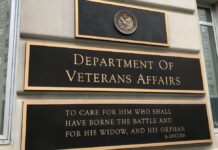Top Republicans have sent a letter to acting National Institutes of Health (NIH) Director Dr. Lawrence Tabak regarding the agency’s handling of sexual harassment complaints.
House Energy and Commerce Committee Chair Cathy McMorris Rodgers (R-WA), Subcommittee on Health Chair Brett Guthrie (R-KY), and Subcommittee on Oversight and Investigations Chair Morgan Griffith (R-VA) want a response to their August 2022 inquiry, which has gone unanswered.
NIH’s own statistics show a significant problem with more than 300 cases related to harassment since 2018. That also represents hundreds of women who are being bullied or threatened.” […] “All the more troubling is the fact that recent independent surveys have found top institutions and major NIH grant recipients with a high number of reported instances of sexual misconduct. In 2015, the Association of American Universities (AAU) conducted a campus survey on Sexual Assault and Sexual Misconduct. This survey included over 150,000 undergraduate, graduate, and professional students at 27 universities that participated. For example, Yale University had the highest rates of female sexual assault with the exception of two other universities, which both boast a significantly larger student body population. Further, in 2019, AAU conducted a follow up Campus Sexual Assault and Sexual Misconduct survey and found that sexual assaults at Yale had actually increased.
“Such findings and high-profile cases raise concerns about possible non-compliance with Federal laws applicable to NIH funding, including Title IX. As you know, Yale has been among the largest recipients of Federal taxpayer funding in the form of research grants.
During the past ten years, for example, Yale has received approximately 9,584 awards to faculty and professors totaling around $4.3 billion from NIH alone. Each of these grants were conditioned on Yale’s full compliance with applicable Federal laws such as Title IX. We could cite several other major grantee institutions for similar issues.
“Based on the massive number of NIH grants and billions of Federal funds benefitting or inuring to the benefit of Yale and ongoing inquiries, we are concerned that Yale and other institutions may not have complied with their responsibilities under Title IX as a recipient of Federal funds.
Compliance with Title IX is more than a mere formality—it is a prerequisite for receipt of Federal funds. Additionally, the Department of Health and Human Services (HHS) asserts that complying with research grant requirements is a significant priority.”
House Republicanss
The Republicans are asking for the following information, including responses to the following questions, by March 28, 2023:
- Upon receipt of a harassment complaint, what is the NIH process for requesting more information from grantees?
- Does the NIH ask different questions if special populations (children) are involved in the complaint?
- Does the NIH ever talk to the alleged victim of harassment, not just the grantee institution?
- How many complaints were sent directly to the NIH Director or Acting NIH Director since January 1, 2019?
- How many of these complaints were referred to the OER? If there were any complaints not referred to OER, why not?
- NIH indicated it was working with HHS Office of Civil Rights in September 2020. What was the outcome of these interactions?
- How many targets of discrimination or retaliation have been contacted as a result?
- Were NIH investigations or institutional Title IX investigations (or others) reviewed? Please provide specifics.
Read full letter here or below.
Lawrence A. Tabak, D.D.S., PhD.
Senior Official Performing the Duties of NIH Director National Institutes of Health
9000 Rockville Pike
Bethesda, MD 20892
Dr. Tabak,
Having not received a response to our letter on August 11, 2022 and pursuant to Rules X and XI of the U.S. House of Representatives, we write to request information from the National Institutes of Health (NIH) about its handling of sexual harassment complaints.
This request follows up and renews a request made to NIH on this subject in a letter dated August 11, 2022. That letter followed up on the NIH’s September 17, 2021, response, and its October 26, 2021, briefing with Republican committee staff regarding NIH’s handling of sex harassment complaints. In its written response, the NIH stated that it was constrained from investigating sexual misconduct at grantee institutions once the alleged perpetrator no longer is affiliated with grantee institutions. However, this narrow view begs the question of an alleged perpetrator who is no longer affiliated with a grantee institution, but is still affiliated with the NIH by co-chairing an NIH institute steering committee. Our letter focused on the case of Axel Grothey, an oncologist who continued to co-chair a National Cancer Institute steering committee despite being disciplined by three states for inappropriate sexual conduct. Further, one of the complainants had no communication from the NIH, not even an acknowledgement of the complaint or even to tell her that NIH truly could not investigate the matter.1 Only after The Cancer Letter reported on this situation did the NIH finally act to remove Dr. Grothey from the steering committee, two years after complainants contacted the NIH.
1 NIH ignored my report of sexual misconduct by Axel Grothey—and danced around questions from Congress, The Cancer Letter (October 1, 2021).
The issue arising from the Grothey case is only one manifestation of a broader concern affecting NIH grantees and NIH-supported researchers. NIH’s own statistics show a significant problem with more than 300 cases related to harassment since 2018. That also represents hundreds of women who are being bullied or threatened.
NIH has made combatting sex harassment a high priority. In his September 21, 2018, blog, then NIH Director Francis Collins stated:
I plan to ask the Committee [National Science and Technology
Council Committee on Science] to consider uniform measures that
would be most effective in changing the pervasive culture of
sexual harassment in science, and fostering a culture of respect for
all. I personally consider addressing this matter to be a high
priority for NIH.2
Although he wrote that he personally considered changing the culture of sexual harassment in
science a high priority for NIH, he did not sign the response letter to us. Instead, you signed the
letter when you were serving as the Principal Deputy Director of the NIH.
We acknowledge that the NIH has issued several policies and there have been efforts at the Office of Extramural Research (OER) to strengthen NIH’s responsiveness.3 NIH provided an overview of harassment reports as of October 24, 2021, to the then-minority Committee staff. (See attachment for August 11, 2022 letter). Table 1 of the overview showed a total of 390 harassment reports submitted from calendar year 2018 to October 22, 2021, described by NIH as“a large number of complaints.” According to NIH’s descriptions of the harassment cases, more than 62 percent of the cases included either a sex harassment allegation alone or a sex harassment allegation along with other allegations. Table 2 in the overview showed a list of findings and outcomes of the cases reported to the NIH OER.
However, during the briefing, NIH acknowledged past understaffing issues and the Committee staff expressed concern to the NIH about insufficient public communication. Thus, we have concerns that NIH’s actions thus far are not adequate to ensure a safe and functional biomedical research workplace given the apparent scale of the challenges.
All the more troubling is the fact that recent independent surveys have found top institutions and major NIH grant recipients with a high number of reported instances of sexual misconduct. In 2015, the Association of American Universities (AAU) conducted a campus survey on Sexual Assault and Sexual Misconduct. This survey included over 150,000 undergraduate, graduate, and professional students at 27 universities that participated.4 For
2 The National Institutes of Health (NIH), Changing the culture of science to end sexual harassment, (September 17, 2018), available at
3 The National Institutes of Health (NIH), Supporting a Safe and Respectful Workplace at Institutions that Receive NIH Funding, available at https://grants.nih.gov/grants/policy/harassment.htm.
4 Cantor, David et al. (Sept. 21, 2015), Report on the AAU Campus Climate Survey on Sexual Assault and Sexual Misconduct, Westat, available at
https://www.nih.gov/about-nih/who-we-are/nih-director/statements/changing-culture-science-
end-sexual-harassment.
2
example, Yale University had the highest rates of female sexual assault with the exception of two other universities, which both boast a significantly larger student body population. Further, in 2019, AAU conducted a follow up Campus Sexual Assault and Sexual Misconduct survey and found that sexual assaults at Yale had actually increased.
Such findings and high-profile cases raise concerns about possible non-compliance with Federal laws applicable to NIH funding, including Title IX. As you know, Yale has been among the largest recipients of Federal taxpayer funding in the form of research grants. During the past ten years, for example, Yale has received approximately 9,584 awards to faculty and professors totaling around $4.3 billion from NIH alone. Each of these grants were conditioned on Yale’s full compliance with applicable Federal laws such as Title IX. We could cite several other major grantee institutions for similar issues.
Based on the massive number of NIH grants and billions of Federal funds benefitting or inuring to the benefit of Yale and ongoing inquiries, we are concerned that Yale and other institutions may not have complied with their responsibilities under Title IX as a recipient of Federal funds. Compliance with Title IX is more than a mere formality – it is a prerequisite for receipt of Federal funds. Additionally, the Department of Health and Human Services (HHS) asserts that complying with research grant requirements is a significant priority.5
In light of these concerns, please provide the following by March 28, 2023:
- For Table 2, please provide more details about the outcomes listed as “other grant actions.”
- Upon receipt of a harassment complaint, what is the NIH process for requesting more information from grantees?
- Does the NIH ask different questions if special populations (children) are involved in the complaint?
- Does the NIH ever talk to the alleged victim of harassment, not just the grantee institution?
- When a Principal Investigator is removed, does the NIH ask the grantee institution about safety management for affected individuals?
- For physicians involved in harassment complaints submitted to the NIH, is patient harm viewed as part of sex harassment?
https://www.aau.edu/sites/default/files/@%20Files/Climate%20Survey/AAU_Campus_Climate_Survey_12_14_15. pdf.
5 U.S. Department of Health and Human Services (HHS), Title IX of the Education Amendments of 1972, available at https://www.hhs.gov/civil-rights/for-individuals/sex-discrimination/title-ix-education-amendments/index.html.
3
- How many complaints were sent directly to the NIH Director or Acting NIH Director since January 1, 2019? How many of these complaints were referred to the OER? If there were any complaints not referred to OER, why not?
- How many complaints were sent directly to a Director of an NIH institute or center? How many of these complaints were referred to OER? If there were any complaints not referred to OER, why not?
- If a grantee institution retaliated against a complainant, how would the NIH know about it, and what actions would be taken?
- For Table 2, please expand on the data to include recipient institutions and the alleged perpetrators by name in cases where the allegation was substantiated.
- How many reports included allegations of retaliation in addition to and apart from harassment, bullying, or other forms of discrimination?
- NIH indicated it was working with HHS Office of Civil Rights in September 2020. What was the outcome of these interactions? How many targets of discrimination or retaliation have been contacted as a result? Were NIH investigations or institutional Title IX investigations (or others) reviewed? Please provide specifics.
- How much has the NIH allocated to respond to targets and survivors in harassment cases involving the NIH in some way?
- Following the Grothey case, it is evident that power granted by the NIH is not limited to academic institutions and grant recipients but also to large, funded networks. How many network investigators have been the subject of harassment allegations? How were these allegations handled within the network? How many were removed from network activities at the time of the NIH’s knowledge of the allegations? Were co-chairs and other members of committees notified? How were access to funding lines, publications and network resources handled for the alleged perpetrators? Please provide specific numbers for each network and outcomes as known.
- The NIH reports to have the ability to request Title IX (and possibly other) investigations outside of the NIH. In how many cases were these requested? What determines whether these are requested? In reviewing the OER’s policy, if noncompliance with Title IX protocols is found, what steps does the NIH take?
9. How does the NIH detect the “passing the rogue” problem (i.e., universities exchanging faculty members accused of misconduct) referenced in NIH’s PowerPoint presentation during the October 26, 2021, staff briefing?
4
- Please provide a breakdown of allegations and outcomes by discipline (scientific and/or clinical for MDs).
- NIH has created a separate reporting mechanism by which victims or targets may report and responses often indicate a “need to know” basis. Please define criteria or circumstances by which NIH feels a reporter/target/survivor needs to know?
- As in the Grothey case, the persistence of a perpetrator in a position of power leads survivors and advocates to report. How are letters to institute directors or direct reports to the NIH personnel handled? Since 2018, how many victims and/or complainants who have agreed to speak with the NIH been followed up with?
- Has the NIH contacted any complainants to assess their sense of safety after disciplinary action to validate institutional reports?
- Following reports to the NIH, how many follow up communications from complainants requesting any information pertinent to a prior allegation involving NIH grants or its handling have the NIH responded to? What is the median response time (aggregate by year please)? How many have not been responded to and why?
- The NIH states it does not intervene in personnel matters. Workplace harassment can involve violence and contributes to an unsafe work environment. When do safety concerns (violence, threatened violence) prompt intervention as a result of environment? How many reports involve security measures for the target, bystander, and/or perpetrator? How is this detailed in ongoing follow up? How is this required prior to awarding of new grants to an institution?
- How does the NIH work with the grantee institution in instances where violence has occurred? Are the perpetrators ever stripped of grants?
- In what percentage of cases where NIH grants were involved with harassment were the subjects of the complaint involved with decision making? How many gave subjects the opportunity to be involved?
- How many complainants were willing to speak with the NIH? With how many did the NIH speak with specific attention to institutional handling, safety, retaliation, and/or restorative justice processes?
- The 2018 National Academies of Sciences, Engineering, and Medicine (NASEM) report6 listed women in medicine as particularly vulnerable to harassment. The pandemic has
6 National Academies of Sciences, Engineering, and Medicine (NASEM), Sexual Harassment of Women: Climate, Culture, and Consequences in Academic Sciences, Engineering, and Medicine (2018), available at
5
added additional strains and mental health challenges to this population. Have complainants in medicine who reported since 2018 been offered specific supports?
- Please give the ranges of durations for investigations of which the NIH has inquired. When the NIH is aware of an open investigation, with what frequency do they inquire with the institution? What questions are asked with regards to safety measures?
- Women of color are also particularly vulnerable to sexual harassment. How is the NIH handling reports from intersectional discrimination cases?
- The NIH states that it follows media reports for information on sexual misconduct. Please expand on how this is conducted, where the database is maintained, who has access, what is done with the information and how follow up is conducted for any potential victims. Several media stories have captured serial sexual misconduct at the institutional level. Will the NIH require reporting when institutions are under criminal investigation for sexual misconduct?
- What is the credentialing requirement for NIH officials handling reports of harassment or abuse? Are personnel trauma-informed? Are recipient institutions encouraged or required to have trauma-informed personnel handle victims/complainants for investigations and post determination?If you have questions about this correspondence, please contact Alan Slobodin of the
Majority Committee Staff at (202) 225-3641.
Sincerely,
H. Morgan Griffith
Chair
Subcommittee on Oversight and Investigations
cc: Frank Pallone Jr., Ranking Member, Energy and Commerce Committee Kathy Castor, Ranking Member, Subcommittee on Oversight and Investigations
https://nap.nationalacademies.org/catalog/24994/sexual-harassment-of-women-climate-culture-and-consequences- in-academic.
Cathy McMorris Rodgers
Chair
Energy and Commerce Committee
6









